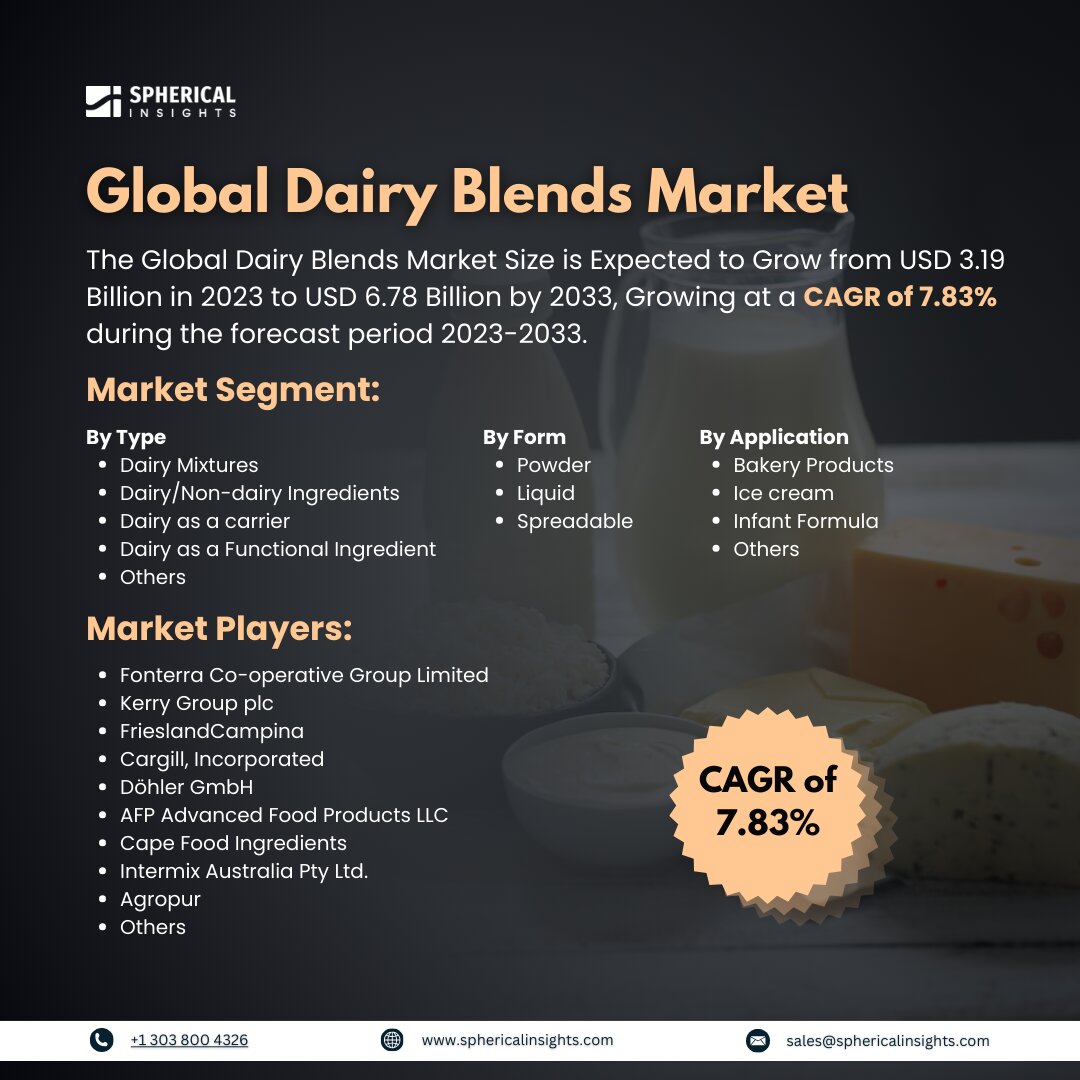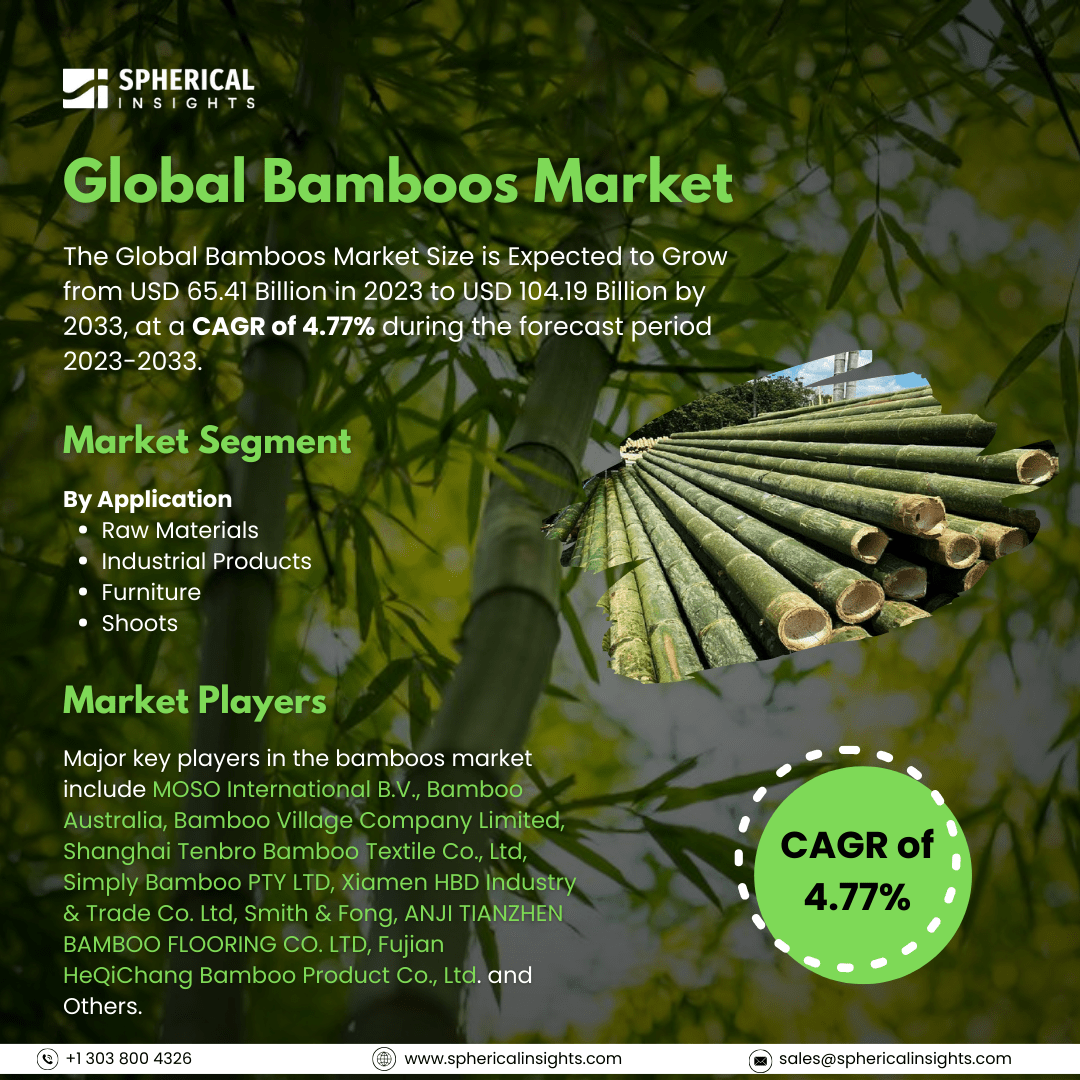Global Dairy Blends Market Size to Worth USD 6.78 Billion by 2033
According to a research report published by Spherical Insights & Consulting, the Global Dairy Blends Market Size is Expected to Grow from USD 3.19 Billion in 2023 to USD 6.78 Billion by 2033, Growing at a CAGR of 7.83% during the forecast period 2023-2033.
Browse key industry insights spread across 215 pages with 110 Market data tables and figures & charts from the report on the Global Dairy Blends Market Size, Share, and COVID-19 Impact Analysis, By Type (Dairy Mixtures, Dairy/Non-dairy Ingredients, Dairy as a carrier, Dairy as a Functional Ingredient, and Others), By Form (Powder, Liquid, and Spreadable), By Application (Bakery Products, Ice cream, Infant Formula, and Others), and By Region (North America, Europe, Asia-Pacific, Latin America, Middle East, and Africa), Analysis and Forecast 2023 – 2033.
Dairy blends are composed of combining butter and consolidated cream. Since it contains vegetable oil, it can be spread over bread and consumed with it. Dairy mixes provide products with a more authentic and genuine flavor. The availability of various kinds of dairy blend flavors is one of the key elements anticipated to support the market's expansion over the forecast period. Further, it is projected that the market for dairy blends will expand due to consumers' increased health concerns. Owing to its well-established health benefits, the dairy blend is utilized in a variety of industries, including bakery, confectionery, food and beverage, and infant nutritional formulas. This market's wide range of applications has become a major growth driver. Consumer preferences for food products are quickly changing to include more convenient and nutrient-dense options. Dairy blend products have become a more affordable option to whole milk products due to improvements in their quality, consistency, and shelf life brought about by advancements in dairy processing processes. However, the market for dairy blends is expected to grow more slowly due to the rising costs of traditional dairy commodities.
The dairy/non-dairy ingredients segment is expected to hold the largest market share of the global dairy blends market through the forecast period.
Based on the type, the dairy blends market is categorized into dairy mixtures, dairy/non-dairy ingredients, dairy as a carrier, dairy as a functional ingredient, and others. Among these, the dairy/non-dairy ingredients segment is expected to hold the largest market share of the global dairy blends market through the forecast period. Dairy/non-dairy ingredients are mixtures of dairy and non-dairy ingredients that appeal to customers with certain nutritional requirements or preferences by providing them with the advantages of dairy products together with substitute ingredients that boost the market growth.
The spreadable segment is predicted to hold a significant market share in the global dairy blends market over the projected timeframe.
Based on the form, the dairy blends market is classified into powder, liquid, and spreadable. Among these, the spreadable segment is predicted to hold a significant market share in the global dairy blends market over the projected timeframe. Spreadable dairy blends are in high demand due to consumer preference for ready-to-eat, convenient products. Customers may save time by using these goods, which also tie in with their current lifestyle routines. Spreadable dairy blends, for instance, are promoted as healthier substitutes for conventional butter, mayonnaise, and margarine. Their demand has increased as a result of their reduced fat content and the incorporation of extra nutrients during the manufacturing process, which have been positively received by health-conscious consumers.
The bakery products segment is anticipated to hold the highest market share of the global dairy blends market through the projected period.
Based on the application, the dairy blends market is classified into bakery products, ice cream, infant formula, and others. Among these, the bakery products segment is anticipated to hold the highest market share of the global dairy blends market through the projected period. Owing to their creative flavor and useful qualities, dairy blends have found widespread use in the production of cakes, buns, bread, biscuits, and more. Since dairy blends have a high nutritional value and may quickly satisfy health-conscious customers, bakers frequently view them as great alternatives to traditional milk and butter. In the bakery market, their appeal is further fueled by customized dairy blends with different nutritional qualities.
Asia Pacific is expected to hold the largest share of the dairy blends market through the forecast period.
Asia Pacific is expected to hold the largest share of the dairy blends market through the forecast period. There is an extensive supply network for the production of dairy blends because prominent nations in this region, such as Australia and India, have long been significant dairy producers. Raw materials for dairy blends have reasonable costs because of the abundance of manufacturing. Additionally, infrastructure expenditures and subsidies, among other beneficial government policies, helped in the expansion of the dairy blend sector in this region.
North America is predicted to grow at the fastest CAGR of the dairy blends market over the forecast period. Owing to the region's well-established and highly developed dairy processing infrastructure, which can produce various kinds of dairy products, including dairy blends. Product innovation, quality assurance, and efficient production are made possible by this. Additionally, a strong market for dairy blends is guaranteed by North America's well-established dairy-eating culture. The desire for innovative dairy blend formulations has been driven by consumer preferences for flavor, convenience, and nutritional value.
Competitive Analysis
Major key players in the dairy blends market include Fonterra Co-operative Group Limited, Kerry Group plc, FrieslandCampina, Cargill, Incorporated, Döhler GmbH, AFP Advanced Food Products LLC, Cape Food Ingredients, Intermix Australia Pty Ltd., Agropur, and others.
Recent Developments
- In July 2024, a new dairy plant in Indonesia's West Java province was inaugurated according to a statement from Frisian Flag Indonesia, a division of FrieslandCampina. The company's main hub in Southeast Asia would be this factory, which would also allow its dairy industry to expand internationally. The facility will be able to produce 700 million kg of dairy products, including milk mixes, annually.
- In February 2024, Fonterra Co-operative Group Ltd. announced that Fonterra Australia and Fonterra Brands New Zealand, the company's dairy businesses in Australia and New Zealand, would soon be merged. It is anticipated that the company's position in this region will be further reinforced by this strategic integration initiative.
Key Target Audience
- Market Players
- Investors
- End-users
- Government Authorities
- Consulting And Research Firm
- Venture capitalists
- Value-Added Resellers (VARs)
Market Segment
This study forecasts revenue at global, regional, and country levels from 2023 to 2033. Spherical Insights has segmented the dairy blends market based on the below-mentioned segments:
Global Dairy Blends Market, By Type
- Dairy Mixtures
- Dairy/Non-dairy Ingredients
- Dairy as a carrier
- Dairy as a Functional Ingredient
- Others
Global Dairy Blends Market, By Form
Global Dairy Blends Market, By Application
- Bakery Products
- Ice cream
- Infant Formula
- Others
Global Dairy Blends Market, By Regional Analysis
- North America
- Europe
- Germany
- UK
- France
- Italy
- Spain
- Russia
- Rest of Europe
- Asia Pacific
- China
- Japan
- India
- South Korea
- Australia
- Rest of Asia Pacific
- South America
- Brazil
- Argentina
- Rest of South America
- Middle East & Africa
- UAE
- Saudi Arabia
- Qatar
- South Africa
- Rest of the Middle East & Africa



